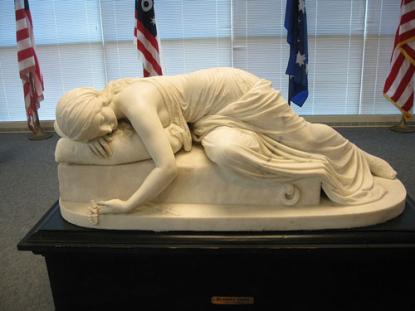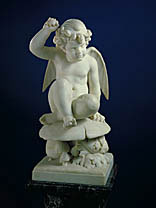
I recently watched an interview with David McCullough on Book-TV, a marvelous weekend program on C-Span2 that I heartily recommend. The principal subject of the interview was McCullough’s admirable new book, The Greater Journey: Americans in Paris, which, as its title suggests, tells the stories of a number of prominent Americans—politicians, artists, writers, etc.—who spent time in Paris, France during the period 1830-1900. For most of these individuals, their time in Paris was educational and formative and their Parisian experiences had a great influence on their subsequent careers in the United States.
The interview with McCullough was enlightening (as is his book). But, perhaps because I am by nature a bit of a contrarian, it led me to the reflection that Paris was not the only city on the European continent to which Americans flocked during the nineteenth century. Indeed, other cities offered riches to American cultural and artistic pilgrims that Paris might not have been able to provide.
For sculptors, in particular, it was not Paris, but Rome that was the chief place to be. Not least, they wanted to study the antique, which was available to them in the Vatican collections; they also had before them in Rome incomparable sculptural masterpieces publicly available, such as those of Michelangelo and Bernini. (For painters, like J.M.W. Turner, the Roman campagna seemed an inexhaustible wellspring of inspiration.) The magnetic attraction of Rome for most aspiring sculptors in the nineteenth century is illustrated by the fact that the eponymous hero of Henry James’s first published novel, Roderick Hudson (1875), an American sculptor of some talent living in Northampton, Massachusetts, is sent, by his benefactor, to Rome to discover and hopefully perfect his genius. In this, the fictional Hudson was following the path already laid down in real life by the world-famous sculptor William Wetmore Story (1819-1895), the son of a Supreme Court Justice and a lawyer himself (and the author of leading treatises on the law of contracts and of sales), who, upon abandoning law for his art, moved to Rome in 1850 and lived there grandly, in the Palazzo Barberini, until his death.
Several of Story’s sculptures are on display at Memorial Hall at Harvard University, including a bust of his father, Supreme Court Justice Joseph Story, and a self-portrait given to Harvard by his son. Story’s beautiful full-length statue of Medea graces the new American Wing at Boston’s Museum of Fine Arts. Probably by design, the Medea is displayed at the new MFA American gallery of 19th Century art right in front of Washington Allston’s famous self-portrait (complete with Phi Beta Kappa key), painted in Rome in 1805. Allston was yet another American artist who spent time in and drew inspiration from the Eternal City. (The first painting given to the MFA was by Allston and, in fact, in his day Allston was so famous that at one point, Alice Hooper, the donor of the Allston self-portrait, suggested that the MFA be called the “Allston Museum.”)
 Perhaps the most intriguing group of American artists who chose to make Rome their primary Continental destination were the group of American women sculptors, who gathered around their most famous member, Harriet Hosmer (1830-1908).[i] Born in Watertown, Massachusetts, Hosmer went to Rome with a female friend in 1852 and stayed for a number of years. Best known today for sculptures such as Zenobia in Chains, which may be seen today at the Wadsworth Athenaeum in Hartford, Connecticut, her initial success came from her sculpture of Puck, of which she made many copies (one may be found today at the library in Watertown, her original hometown and where she died). Such was the demand for Hosmer’s work that she was paid $5,000 for her sculpture The Sleeping Faun.
Perhaps the most intriguing group of American artists who chose to make Rome their primary Continental destination were the group of American women sculptors, who gathered around their most famous member, Harriet Hosmer (1830-1908).[i] Born in Watertown, Massachusetts, Hosmer went to Rome with a female friend in 1852 and stayed for a number of years. Best known today for sculptures such as Zenobia in Chains, which may be seen today at the Wadsworth Athenaeum in Hartford, Connecticut, her initial success came from her sculpture of Puck, of which she made many copies (one may be found today at the library in Watertown, her original hometown and where she died). Such was the demand for Hosmer’s work that she was paid $5,000 for her sculpture The Sleeping Faun.
One remarkable woman sculptor who spent time in Rome was Anne Whitney (1821-1915), whose family lived in Belmont, but who, like Hosmer, had been born in Watertown, Massachusetts. Whitney, eight years older than Hosmer, did not come to Rome until 1867, but like Hosmer she quickly became involved with the artistic milieu at the time (including an obligatory visit to William Wetmore Story’s studio in the Palazzo Barberini). Whitney was an accomplished artist: three of her famous and skillful sculptures grace public places in and around Boston: the Monument to Samuel Adams (1880) which stands in front of Fanueil Hall in Boston; the Monument to Charles Sumner (1875; recast in bronze in 1902), a splendid seated figure located in Harvard Square, Cambridge: and, finally, also in Boston the Monument to Leif Erikson (1877), a standing figure located at Charlesgate on Commonwealth Avenue.[ii]
It is our good fortune that Anne Whitney’s unpublished correspondence covering, among other things her years in Rome (1867-71), has been preserved in the Wellesley College Archives. Whitney’s observations about her art, her fellow artists, and the political events and movements of the time (she was in Rome right after the American Civil War and just at the time of unification of Italy) are of great value, and should be better known.[iii]
Another famous sculptor who came to Rome was the New Yorker, Augustus Saint-Gaudens. To be sure, as McCullough discusses in The Greater Journey, unlike the sculptors discussed above, Saint-Gaudens first went to Paris in 1867 (the same year that Anne Whitney came to Rome) with the intention of there learning to be a sculptor.[iv] However, with the advent of the Franco-Prussian war (and prior to the Paris Commune), Saint Gaudens left Paris for Rome, where his studio backed onto the garden of the Palazzo Barberini, where, as already noted, William Wetmore Story had his studio. It was while in Rome that Saint-Gaudens continued to perfect his art, worked on his first commissions and met his future wife, Augusta (a native of Roxbury, Massachusetts). All-in-all, Saint-Gaudens spent five years in Rome, of which too little is know because of a 1904 studio fire that destroyed his Rome letters and papers. Augusta’s letters are all that survive of Saint-Guadens time in Rome (and, to his great credit, David McCullough makes use of Augusta’s letters in his book).
It was after his Rome sojourn and his return to New York that Saint-Gaudens’s career really took off, kicked into high gear by the Farragut Memorial (sited in Union Square Park at 14th Street, in New York City), which he worked on chiefly in Paris. But the influence of Rome and the Italian sculpture of his day on Saint-Gaudens’s work has been recognized, and was recently the subject of an exhibit at the Museo Vincenzo Vela in Switzerland.
In short, as important a center of culture as it was in the nineteenth century, Paris was not the only beacon for 19th century Americans hungry for artistic skill and knowledge. Rome, the Eternal City, too, had its share of Americans, and it, too, contributed to the artistic and cultural legacy that we enjoy today.
[i] In a famous pejorative description, perhaps implicitly referring to the sexual orientation of many of the women involved, who were in committed relationships with other women, Henry James famously described the circle that gathered around Hosmer as “that strange sisterhood of American ‘lady sculptors’ who at one time settled upon the seven hills in a white marmorean flock.” Henry James, William Wetmore Story and His Friends: From Letters, Diaries and Recollections, 2 vols, Boston, 1903, I, p. 257.
[ii] The Leif Erikson sculpture exists, one presumes, because of the fable created by some Bostonians in the 19th century that a member of the pure Nordic races, namely Leif Erikson (and not the Italian Christopher Columbus) was the original discoverer of the United States. Whatever its reason for being, it is a marvelous work, that, like so much public sculpture these days, is probably rarely looked at carefully, since to do so one must, in this case, cross Commonwealth Avenue just at the convergence of the Kenmore Square exit and entrance to Storrow Drive.
[iii] For an illuminating discussion of Anne Whitney’s Rome letters and what they say about not only the artistic community in Rome at the time but also about political events of the period, see Nancy J. Scott, ‘Dear Home’: a sculptor’s view from Rome, 1867-71; the unpublished letters of Anne Whitney, Sculpture Journal, 17.1 (2008).
[iv] As McCullough points out, 1867 was the year of the Exposition Universelle in Paris, “the year it seemed the whole world came to Paris.” (The Greater Journey, p. 239). But Saint-Gaudens’s idea that he should come to Paris to learn sculpture was also probably influenced by the fact that his father was French, and offered to pay Saint-Gaudens’s passage to Paris for the Exposition. (Id., p. 240).


